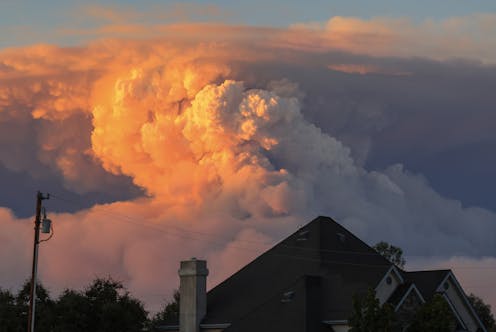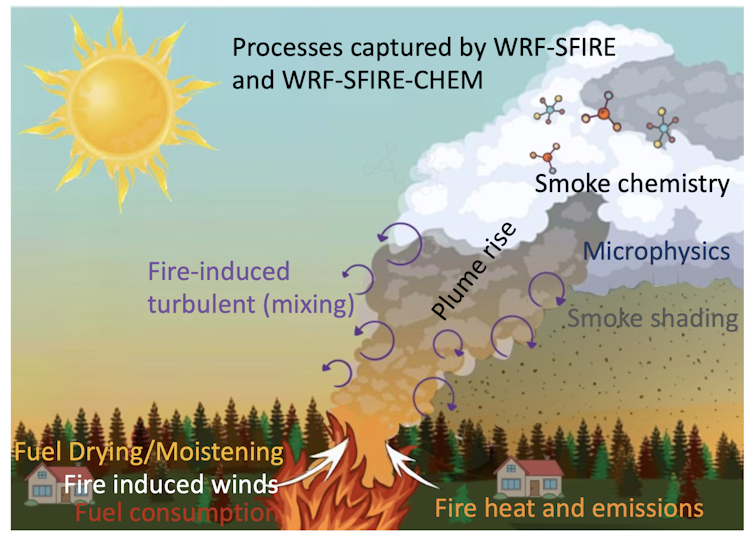Wildfires can create their own weather, further spreading the flames − an atmospheric scientist expl
Fire-produced thunderstorms and tornado-like fire whirls are more common than anyone realized, as high-resolution satellite images and data now show.

Wildfire blowups, fire whirls, towering thunderstorms: When fires get large and hot enough, they can actually create their own weather.
In these extreme fire situations, firefighters’ ordinary methods to directly control the fire don’t work, and wildfires burn out of control. Firefighters have seen many of these risks in the enormous Park Fire burning near Chico, California, in summer 2024.
But how can a fire create weather?
I’m an atmospheric scientist who uses data collected by satellites in weather prediction models to better anticipate extreme fire weather phenomena. Satellite data shows fire-produced thunderstorms are much more common than anyone realized just a few years ago. Here’s what’s happening.
The wildfire and weather connections
Imagine a wildland landscape with dry grasses, brush and trees. A spark lands, perhaps from lightning or a tree branch hitting a power line. If the weather is hot, dry and windy, that spark could quickly ignite a wildfire.
When vegetation burns, large amounts of heat are released. This heats the air near the ground, and that air rises like a hot air balloon because hot air is less dense than cool air. Cooler air then rushes in to fill the void left by rising air.
This is how wildfires create their own wind patterns.

What happens next depends on the stability of the atmosphere. If the temperature cools rapidly with elevation above the ground, then the rising air will always be warmer than its surroundings and it will keep rising. If it rises high enough, the moisture will condense, forming a cloud known as a pyrocumulus or flammagenitus.
If the air keeps rising, at some point the condensed moisture will freeze.
Once a cloud has both liquid and frozen water particles, collisions among these particles can lead to electrical charge separation. If the charge buildup is large enough, an electrical discharge – better known as lightning – will occur to neutralize the charges.
Whether a fire-induced cloud will become a thunderstorm depends on three key ingredients: a source of lift, instability and moisture.
Dry lightning
Wildfire environments typically have limited moisture. When conditions in the lower atmosphere are dry, this can lead to what’s known as dry lightning.
No one living in a wildfire-prone environment wants to see dry lightning. It occurs when a thunderstorm produces lightning, but the precipitation evaporates before reaching the ground. That means there is no rain to help put out any lightning-sparked fires.
Fire whirls
As air rises in the atmosphere, it may encounter different wind speeds and directions, a condition known as wind shear. This can cause the air to spin. The rising air can tilt the spin to vertical, resembling a tornado.
These fire whirls can have powerful winds that can spread flaming ash, sparking new areas of fire. They usually are not true tornadoes, however, because they aren’t associated with rotating thunderstorms.
Decaying storms
Eventually, the thunderstorm triggered by the wildfire will begin to die, and what went up will come back down. The downdraft from the decaying thunderstorm can produce erratic winds on the ground, further spreading the fire in directions that can be hard to predict.
When fires create their own weather, their behavior can become more unpredictable and erratic, which only amplifies their threat to residents and firefighters battling the blaze. Anticipating changes to fire behavior is important to everyone’s safety.
Satellites show fire-created weather isn’t so rare
Meteorologists recognized the ability of fires to create thunderstorms in the late 1990s. But it wasn’t until the launch of the GOES-R Series satellites in 2017 that scientists had the high-resolution images necessary to see that fire-induced weather is actually commonplace.
Today, these satellites can alert firefighters to a new blaze even before phone calls to 911. That’s important, because there is an increasing trend in the number, size and frequency of wildfires across the United States.
Climate change and rising fire risks
Heat waves and drought risk have been increasing in North America with rising global temperatures, more frequently leaving dry landscapes and forests primed to burn. And climate model experiments indicate that human-caused climate change will continue to raise that risk.
As more people move into fire-risk areas in this warming climate, it’s not surprising that the risk of fires starting and spreading is rising. With fires come cascading hazards that persist long after the fire is out, such as burn-scarred landscapes that are much more susceptible to landslides and debris flows that can affect water quality and ecosystems.
It’s important to remember that fire is a natural part of the Earth system. Communities can reduce their vulnerability to fire damage by building defensible spaces and firebreaks and making homes and property less vulnerable. Firefighters can also reduce the surrounding fuel loads with prescribed fire.
As fire scientist Stephen J. Pyne writes, we as humans will have to reorient our relationship with fire so we can learn to live with fire.
Kyle Hilburn receives funding from the National Oceanic and Atmospheric Administration and the National Aeronautics and Space Administration.
Read These Next
West Coast levee failures show growing risks from America’s aging flood defenses
Levees protect more than 7 million buildings in the US today, yet they got a D-plus grade in 2025. A…
LA fires showed how much neighborliness matters for wildfire safety – schools can do much more to te
Managing fire risk is about more than regulations and rules. It’s also about caring for neighbors…
The ‘sacred’ pledge that will power the relaunch of far-right militia Oath Keepers
Founder Stewart Rhodes says he will relaunch the group, serving as an important outlet for thousands…






